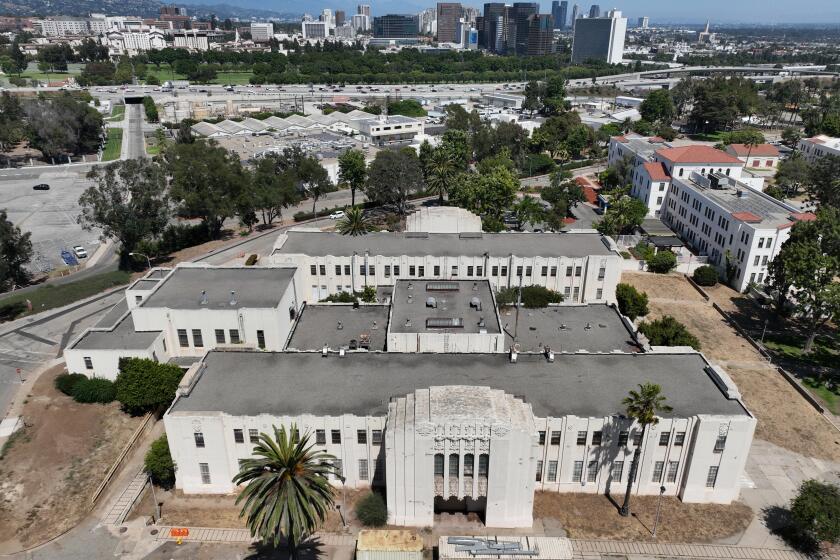Hikers in East Bay Parks Have a Beef With Cows
Jennie Barber was hiking on a narrow trail in the Sunol Regional Wilderness recently when she came upon a mother cow and her newly dropped calf.
The protective cow charged. The next thing Barber knew, she was flying through the air, crash-landing into a barbed-wire fence. The cow then lowered its head, preparing for another attack.
“I seriously thought I was going to die, and what a weird story this was going to be,” said Barber, who survived the Aug. 22 incident with hand and body cuts and a sore tailbone.
What the 35-year-old Oakland hospital worker learned is that cow attacks, along with rattlesnake bites, mountain bike tumbles and twisted ankles, are among the regular dangers faced by intrepid hikers when they venture into the vast public parklands east of Oakland.
Near that same spot three years earlier, hiker Lynn Chambers, 56, of Palo Alto reported being butted to the ground and repeatedly stomped by a mother cow, leaving Chambers severely bruised and fearful of maternal bovines.
“The swelling and bruising was so bad I couldn’t sit down, and I could only sleep in one position for weeks,” Chambers recalled. “From my waist to my knees, the back of my body was dark purple.”
Danville electrical engineer Greg Schneider has made cow attacks one of the main issues in a personal campaign against cattle grazing on public lands. Schneider, 55, says that while walking his two dogs in the publicly owned Sycamore Valley Open Space near his home, “I was chased by six different cows at different times over about a 20-minute period.”
With 96,000 acres spread over 65 sites in the seasonally dry valleys and hills east of Oakland, the East Bay Regional Park District is the largest urban park system in the country. But with 8,000 to 10,000 cattle grazing the land, it is also a major working ranch that local cattlemen lease to fatten their herds.
Especially during late-summer calving season, the cows and park visitors occasionally collide, adding to concerns about the use of public parklands for cattle operations. Park officials estimate there are four or five serious cow attacks -- resulting in injury -- each year. Schneider says that the problem is more serious and that dozens more cases involving minor injuries or no injury go unreported.
More than 15 million people use the park system annually for activities that include horseback riding and butterfly hunting.
Park officials contend that the grazing policy is necessary for fire protection and maintaining grassland. In public hearings four years ago, grazing was strongly supported by most fire departments as well as other large public landholders, including the San Francisco Water Department, which owns and grazes 40,000 acres of watershed next to the Sunol Regional Wilderness.
“Grazing is an essential part of our whole watershed management plan,” said Tim Koopman, a Sunol cattle rancher who manages the water department property for the San Francisco Public Utilities Commission. “It helps reduce vegetation and annual grasses that pose fire hazards.”
Without grazing, said Brian Wiese, chief of planning and stewardship for the Oakland-based East Bay park district, the parks would have to use selective burning and other methods to control the accumulation of dry grasses. Burning, and the resulting pollution, Wiese said, are even less acceptable to the public than grazing.
Park officials object to critics’ portrayal of the urban park system as a giant cattle ranch.
“We don’t have any intention to maximize our beef production,” stewardship manager Joseph DiDonato said. “We are not in the cattle industry. We regulate it closely to make sure that our land does not become a ranch.”
Opponents of grazing contend that it scours the land, pollutes water holes, litters the parks with cow manure and sometimes turns dangerous, resulting in attacks by cows.
“Our big beef,” said Jeff Miller, director of environmental group Alameda Creek Alliance, which has sued the park district over its grazing policy, “is that these are public lands in the public domain. Yet what you have occurring on many of these lands is that the primary beneficiary is the private rancher.”
Miller and others point to the nearby 20,000-acre Mount Diablo State Park -- where private grazing was banned in 1990 -- as an example of appropriate management of public lands.
To control fire danger at Mount Diablo, said park Supt. Brian Hickey, his staff has broadened fire lanes and sprayed the sides of roads with herbicides, and taken other steps. He said the park has not had a significant fire since grazing was stopped.
“We’ve been able to return the park to a more natural state,” Hickey said, “by eliminating fencing and cattle-raising infrastructure. There’s the visual benefit of not having cow droppings all over the park, and people are not deterred from using the park by the presence of large animals.”
Even with those benefits, Hickey said, the grazing ban remains controversial there, particularly in the ranching community, which still plays an important economic role in eastern Contra Costa and Alameda counties. According to county agriculture agents, there are about 500 cattle ranches in the two counties, running a total of about 75,000 head.
Since the days of the Spanish land grants, this area has been prime ranchland. The Mediterranean climate of the coastal range and valleys here is ideal for cattle, especially for the cow-calf ranching that is the mainstay of local cattle operations.
In recent decades, ranchers have competed for space with luxury home builders whose mansions sprawl out from the former ranching communities Pleasanton, Danville, Concord, Walnut Creek, Livermore and Sunol.
The growth of developments has increased the ranchers’ dependence on public lands for their grazing properties.
“This has become a different kind of ranching,” said Jim Coehlo, a cattle rancher who leases about 2,000 acres of pasture from the East Bay park system and the San Francisco Water Department. “We graze cattle right next to million-dollar homes.”
The proximity to urban development and the dependency on heavily used public lands, Coehlo said, means ranchers need to be more sensitive to public concerns. “We understand that either we are going to work with the public, or we won’t be ranching in the area,” he said.
Although grazing has been permitted continuously here since the public park and public utilities properties were created in the early 1930s, the political power over them resides in the East Bay cities on the other side of the coastal range.
The East Bay Regional Park system is governed by a five-member elected board. The San Francisco Water Department land falls under the city’s public utilities commission, a five-member body appointed by the mayor.
So far, the regional park board and utilities commission, swayed mainly by the fire threat argument, have been unwavering in their support of grazing. Public hearings on grazing in 2000 resulted in the policy’s continuation.
But park officials are sensitive to potential public challenges, including the relatively new issue of cow attacks raised by Schneider and others.
When Jennie Barber was attacked in late August, for example, park supervisors increased the number of signs in the park warning about the dangers of grazing cattle.
Rancher Russ Fields, who has a grazing permit in the Sunol park, was ordered to identify and remove the aggressive cow from the area where Barber was attacked. Unable to identify the guilty party, Fields moved 19 cows and four calves to another pasture. Park executives came up with a public education program to reduce violent encounters with cattle.
Among the suggestions: encouraging hikers to identify aggressive animals so they can be expelled from the park; instructing visitors to “act big and loud” to scare off cows, and moving the animals away from heavily used trails during the calving season.
“Even if there are only four or five attacks out of 15 million visitors a year,” park official DiDonato said, “it is still too much for us.”
More to Read
Sign up for Essential California
The most important California stories and recommendations in your inbox every morning.
You may occasionally receive promotional content from the Los Angeles Times.










